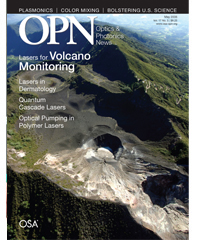
May 2006 Issue
Feature Articles
Laser Absorption Spectroscopy for Volcano Monitoring
Recent advances in infrared laser spectroscopy may enable scientists to make accurate, in situ, real-time measurements of the isotopic composition of gas species emitted from volcanoes.
by Frank K. Tittel, Damien Weidmann, Clive Oppenheimer and Livio GianfraniContinuous-Wave, Room-Temperature Quantum Cascade Lasers
Quantum cascade lasers are now capable of continuous-wave, room-temperature, single-frequency operation with large powers. This progress may be translated into many applications, including medical breath analysis and environmental monitoring.
by Jerome FaistOptical Pumping in Polymer Lasers: Advances and Challenges
Semiconducting or conjugated polymers combine novel semiconducting properties with simple processing. This article explores optical pumping in polymer lasers by highlighting recent advances in ultrafast photonics and the fabrication of polymer laser resonators.
by Nilesh V. PatilAlmost as soon as the first laser was invented, physicians aimed its light at the skin. Today, dermatologists use many types of lasers to treat everything from disfiguring birthmarks to the wrinkles of age.
by Patricia DaukantasDepartments and Columns
A Picture Is Worth a Thousand Fringes
The technology that supports 4D Technology Corp. in Tucson began in 1995 with the study of combustion.
Last month’s column described how OSA came to make optics education an important priority. How did the Society translate that goal into reality? It started with an “action program.”
Government Recognizes Need to Bolster Research
Washington’s newest buzzwords are competitiveness and innovation. From the White House to both sides of Capitol Hill, they’re being offered by everyone as the antidote to widespread worries that the United States is in danger of losing its world economic and scientific leadership.
Demonstrations of color mixing are typically done using lamps with color fi lters or light emitting diodes. We describe how to conduct a color mixing experiment with a spectroscope and the light from a cathode ray tube computer monitor.
Also in this Issue


![Manual probe system with needles for test of semiconductor on silicon wafer. [A. Morozov / Getty]](https://opnmedia.blob.core.windows.net/$web/opn/media/images/articles/2025/1125/departments/202511-cover-web.jpg?ext=.jpg)
![Researcher Clara Saraceno in the lab. [Image by Carsten Behler Photography]](https://opnmedia.blob.core.windows.net/$web/opn/media/images/articles/2025/1025/departments/202510-cover-web.jpg?ext=.jpg)
